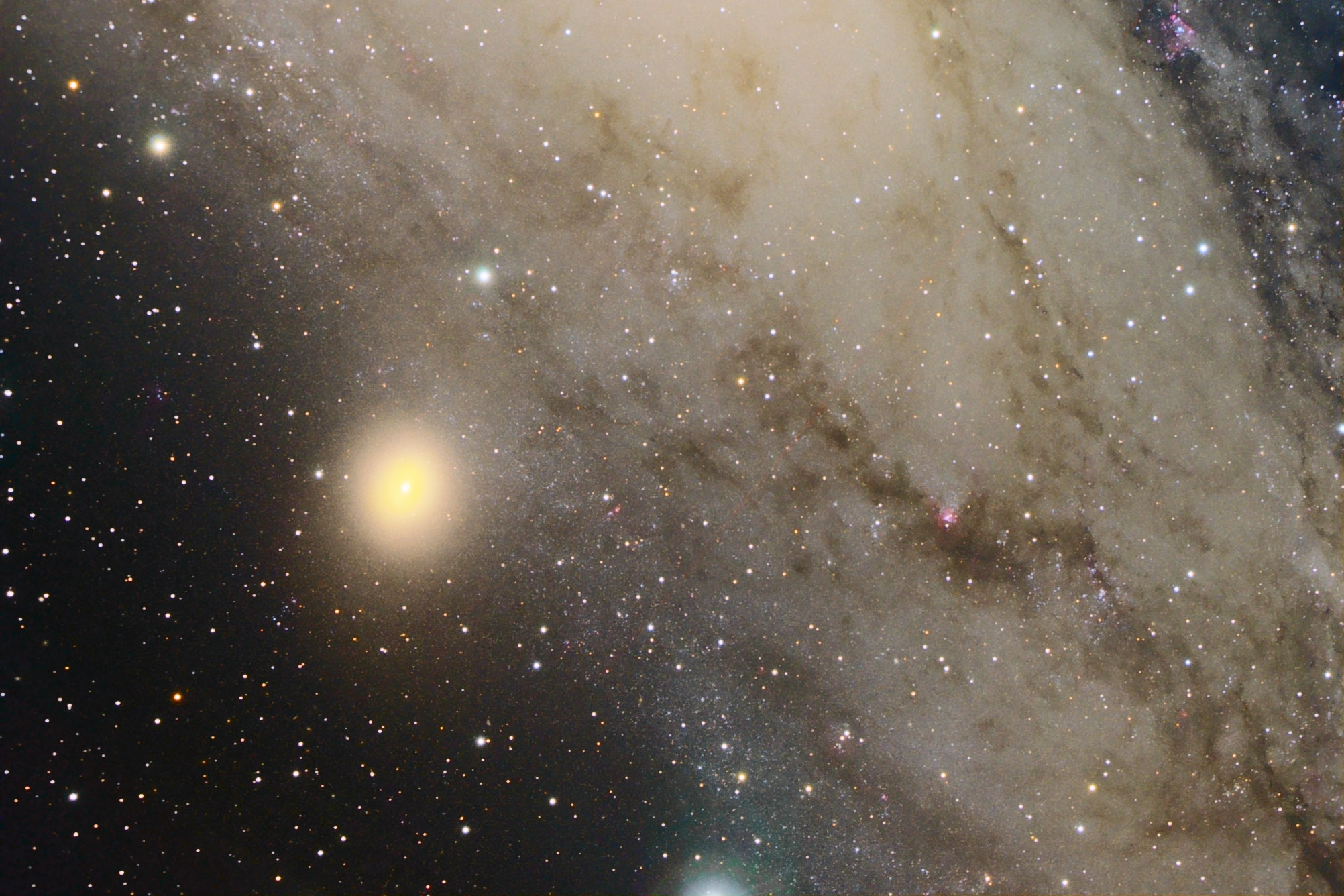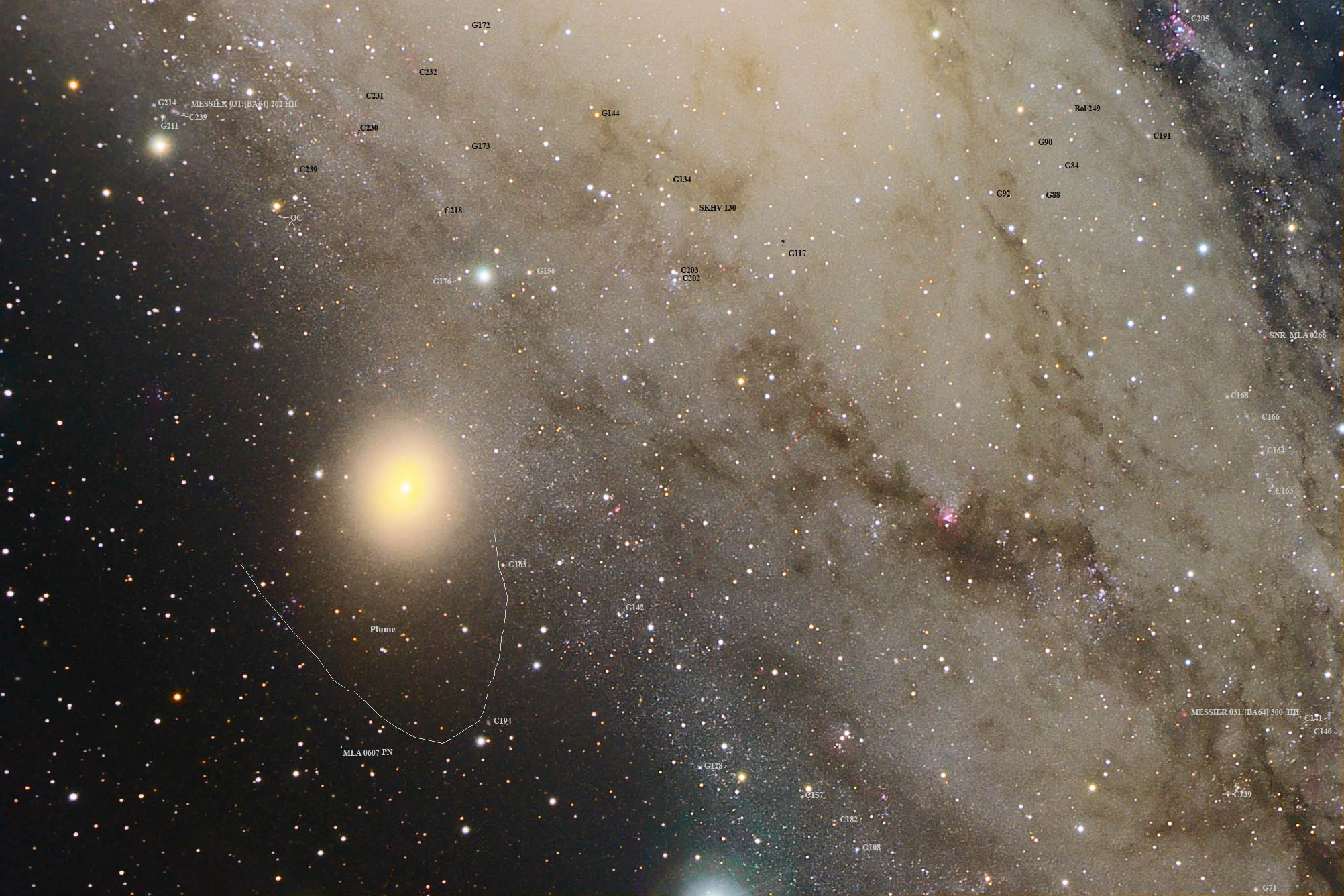Object name: ARP168Designation(s): ARP168, M032, M32 is Number 168 in Arp's peculiar galaxy atlas. That puts it in his Galaxies (not classifiable as S or E): Diffuse counter-tails. How many times have you seen this companion to M31 yet not seen the counter-tail? Yeah, me neither. Arp's comment to this one: "Faint diffuse plume curved away from M31's disk." Odd Arp would consider it neither Elliptical or Spiral. Every source I checked classed it as a compact elliptical galaxy, most saying cE2. The "c" for compact. Most sources say much of its outer halo has been stripped away by the tidal forces of M32 yet the counter tail remains, albeit very faintly. If you blow up the image some of the stars of M32 are resolved around the left and bottom edges. At least I think they are members of M32 rather than M31. Blue M31 stars are seen along the right and top edges of M32 however.
To try and find this nearly invisible plume I exposed for several hours but skies were awful. Only 4 frames had decent seeing and halfway usable transparency. I didn't realize this at the time as I looked only at the first and last of the series and they looked good. But CCDSoft's auto histogram stretch can hide a lot. I didn't realize the first frame had 8 times the light throughput as the last. I ended up using only 4 of the series as that gave the best image. Including more just made the plume even harder to see. Note this was taken the day before my high-resolution C179 image and seeing was very good. Good enough to have binned 1x1 but I wanted the added speed of the 2x2 binning. That was a good choice as only 40 minutes of 1x1 binned data wouldn't have been as good due to added read noise. The color data was useless due to clouds so used the same low-resolution data I used for the previous C179 shot. It wasn't as bad of a match for this image so worked somewhat better.
In the raw data, M32 goes to the far lower left corner of the image. When stretched to bring this out the plume vanished into the background of M31. Probably why few are aware of its existence. Since this outer part of M31 is very blue but the plume from M31 rather red I dimmed down the blue parts of M31 in this area letting the redder features remain. This makes the plume visible though I'm not sure it is curving like Arp says. I don't see the curve on his image either. M32 was first seen by Guillaume Le Gentil on October 29, 1749.
Some of the same features on my close-up of M32 that I ran earlier are seen in this lower resolution image. Many other features beyond the edges of that image are seen as well so I've prepared an annotated image showing these as well. A few on the edges are shown on both but most objects already shown on my C179's annotated image are not included for the most part. Also, see that for details on the labeling scheme used.
G117 is a bit of a puzzle. It is on both Chart 5 and 6 of the atlas but the lines connect to different star-like objects! NED shows the lower and brighter one to be a globular so that is the one I chose to use. NED refers to it as SKHV 117. I put a ? by the other object as it has the PSF of an extended object, rather than a star. Just that it isn't in NED and only "half in" the Hodge atlas.
The image is full of open clusters. I've only identified a few of them. In one place I just put OC and ran lines to three in the area. Many fuzzy patches were not in the Hodge atlas nor NED. I gave up trying to track them down. I could spend months on this image alone. Just not worth it.
What I noticed most was the color of the globulars. Many appeared identical to orange stars but for their PSF not being starlike. Seems most globulars I image in our galaxy seem to have a slightly blue overall color thanks to the highly luminously blue stragglers. Are M31 globulars lacking in such stars, are we seeing them through lots of reddening dust? In any case, the tendency of neutral to orange color seems surprising to me.
There are many differences between NED and the Hodge atlas. For instance, the cluster C205 in the upper right corner is at the location of a very blue starlike object. NED shows no cluster at that point but does show the round emission object just below and left of it as a cluster. This whole region seems to be rather poorly mapped to RA/DEC coordinates. It made it impossible to really pin down which of the many HII regions in this area are which on my image. While NED says the position error is 5" on both axes I was finding nothing within that range. Even when I put those coordinates into the DSS it came up with nothing in that range either but maybe 10" away there was something that might be the object but go 10" another direction and there was another possible object. Move a couple minutes from the area and everything was fine again, I was agreeing within a tenth of a second of arc, not tens of seconds as I and the DSS were in this area. The round bubble below the bright star Hodge sees as a cluster is likely one of the Wolf Rayet bubbles listed by NED in the area. I just can't tell which one. In NED its position is nearly that of a cluster with the WR bubbles further away. I've given up, just enjoy the region. Blow up the image 2x for a better view.
To take out the bad taste left by the above fiasco scan down about halfway to the bottom on the right edge of my image and you'll find a small round red blob. That is listed by NED (coordinates match!) as a Super Nova Remnant they call MLA 0266. Looks like it would be grand as seen from a few thousand light years rather than a few million.
Arp's image, apparently with the Schmidt camera not 200" (at least his resolution is well below mine) and rotated so east is up rather than north is at:
http://ned.ipac.caltech.edu/level5/Arp/Figures/big_arp168.jpeg
14" LX200R @ f/10, L=4x10', RGB=4x10'x3 (same as used for C179 image), STL-11000XM, Paramount ME Related Designation(s):1RXS J004242.8+405156, 2MASS J00424182+4051547, 2MASX J00424182+4051546, 2MASXi J0042418+405154, ARK 012, ARP 168, ARP168, BMW-HRI J004242.0+405154, CGCG 0039.9+4036, CGCG 535-016, CXO J004241.8+405155, HDCE 0029 NED002, HOLM 017B, IRAS 00399+4035, KTG 01B, LDCE 0031 NED006, LGG 011:[G93] 008, M032, MCG +07-02-015, MESSIER 032, MESSIER 032:[YLS2015] R1, NGC 0221, NGC 0221:[RW2000] X-02, NSA 127578, PGC 002555, RX J0042.6+4052, RX J0042.7+4051, RX J0042.7+4051:[BEV98] 005, UGC 00452, UZC J004241.8+405154, [SHP97] 188, [SPB93] 009, | | 
